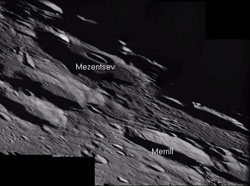An oblique look on the north lunar far west

“This cratered terrain is similar in topography to near-side highlands,” says SMART-1 Project scientist Bernard Foing, “while the far-side equator bulge can reach heights of 7 km, and the South Pole Aitken basin has depths down to 8 km”.
AMIE obtained this sequence on 16 May 2006. The imaged area is centred at a latitude of 73º North and a longitude of 124º West(or 34 º further than the West limb seen from Earth).
Normally, the SMART-1 spacecraft points the AMIE camera straight down, in the so-called Nadir pointing mode. In this image, AMIE was looking out 'the side window' and pointing towards the horizon, showing all craters in an oblique view. The largest craters shown are Mezentesev, Niepce and Merrill, located on the lunar far side, not visible from the Earth. Mezentsev is an eroded crater 89 kilometres in diameter, while Niepce and Merrill have the same size 57 km.
Mezentsev is named after Yourij Mezentsev, a Soviet engineer (1929 – 1965) who was one of the first people to design rocket launchers. Joseph Niepce was the French inventor of photography (1765 – 1833), while Paul Merrill was an American astronomer (1887 – 1961).
Media Contact
More Information:
http://www.esa.int/SPECIALS/SMART-1/SEM787BUQPE_0.htmlAll latest news from the category: Physics and Astronomy
This area deals with the fundamental laws and building blocks of nature and how they interact, the properties and the behavior of matter, and research into space and time and their structures.
innovations-report provides in-depth reports and articles on subjects such as astrophysics, laser technologies, nuclear, quantum, particle and solid-state physics, nanotechnologies, planetary research and findings (Mars, Venus) and developments related to the Hubble Telescope.
Newest articles

High-energy-density aqueous battery based on halogen multi-electron transfer
Traditional non-aqueous lithium-ion batteries have a high energy density, but their safety is compromised due to the flammable organic electrolytes they utilize. Aqueous batteries use water as the solvent for…

First-ever combined heart pump and pig kidney transplant
…gives new hope to patient with terminal illness. Surgeons at NYU Langone Health performed the first-ever combined mechanical heart pump and gene-edited pig kidney transplant surgery in a 54-year-old woman…

Biophysics: Testing how well biomarkers work
LMU researchers have developed a method to determine how reliably target proteins can be labeled using super-resolution fluorescence microscopy. Modern microscopy techniques make it possible to examine the inner workings…





















